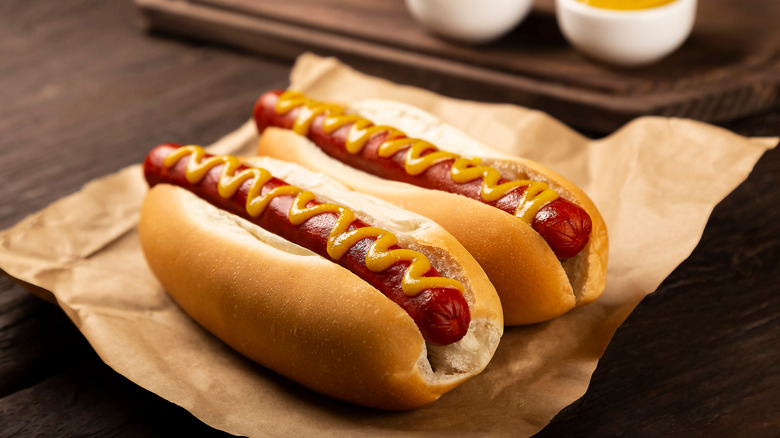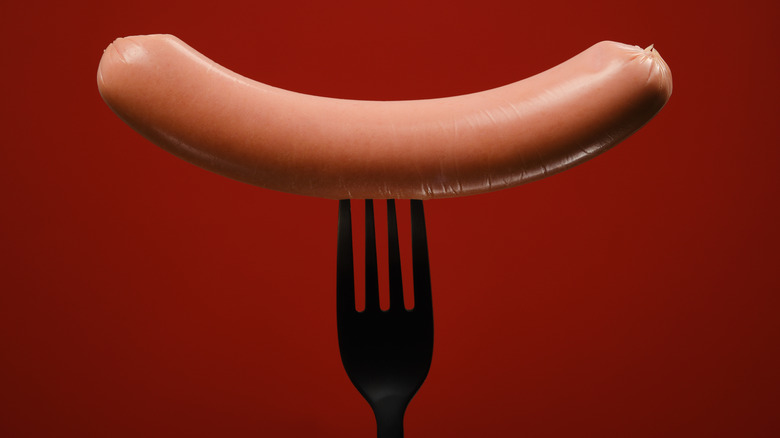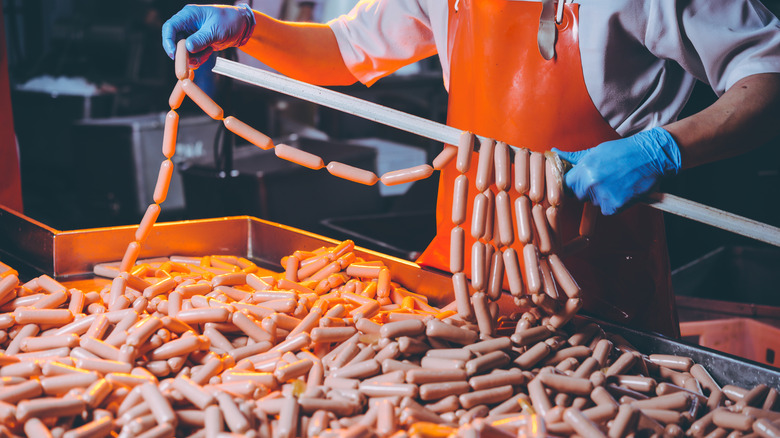What Are Hot Dogs Really Made Of?
It's a question many have wondered, but probably have been afraid to ask. Most nibble away at the hot dogs they've brought to picnics or purchased at a sporting event, trying not to think about it too much. Although hot dogs are one of the most ordinary foods in the world (at least for Americans), they're also shrouded in mystery. Does anyone really want to explore how the sausage is made? Spoiler alert –– it's probably not as scary of a process as you're imagining. Breathe a sigh of relief, even if it's a hesitant one.
Processed meat rumors have launched into collective consciousness like hot dogs from a ball park cannon. From whispers of sausages being made of all manner of unsavory and unnamed parts, to reports claiming they contain human DNA, everyone loves to gawk at hot dog horror stories. Luckily, these have been debunked. Although hot dogs aren't made from prime cuts of meat, they're usually made from meat trimmings and processed into their familiar tube-shaped form, with strict labeling laws ensuring that you know what's in them.
The meat in hot dogs isn't such a mystery
Both hot dogs and food labeling standards have come a long way since the earlier (and probably less appetizing) days of meat processing. The idea that hot dogs contain bits like snouts, lips, and organs is mostly a myth. That is, if those items are in your hot dogs, they'll be called out on the label according to USDA guidelines. Any parts of animals that are not muscle tissue are called out on nutrition labels with the term "byproducts" or "variety meats." However, most of the major brands, like Oscar Mayer, Ball Park, and Hebrew National don't contain byproducts. It's also worth noting that kosher franks and pricier hot dog options will use better quality meats.
The meat found in hot dogs is most often beef or pork trimmings that are left over from cutting pricier cuts of meat like steaks or chops. This meat is ground into a smooth paste (sounds questionable, but stay with us), which sometimes involves a process called mechanical separation, where meat and bones are pushed through a sieve at high pressure to separate them. This process is also used to make chicken nuggets, bologna, lunchmeat, and sausages. Mechanical separation is also something you'll see called out on the ingredient label, and it applies to pork and poultry, but not beef.
A hot dog's final form requires additional ingredients and processing
Once the meat has a consistent texture, then it's mixed with water or ice, seasonings, and other flavor-enhancing ingredients. Depending on the brand, you might see maltodextrin, soy protein concentrate, phosphates, or modified food starch used to improve the texture and mouthfeel of the hot dog. Preservatives are also added to hot dogs to keep them from spoiling, including salt, sodium nitrite, and celery juice powder, which is a naturally occurring source of nitrates used in uncured products. These ingredients also aid in the curing process and give hot dogs their signature pink color (just like their cured meat cousin, ham).
After mixing, the meat is piped into a casing and then twisted into even-length segments. On an industrial scale, it takes a machine a mere 35 seconds to pump out a chain that covers 2x the length of a soccer field. Casings can be edible and snappy, like collagen or cleaned animal intestines, or removable and made from cellulose if you're into skinless hot dogs. Once cased, it's time to cook, usually through steaming and/or smoking. Then, the hot dogs are cooled, inspected, and packaged. So although this seems like a lot of steps, the hot dog-making process isn't so mysterious after all.


